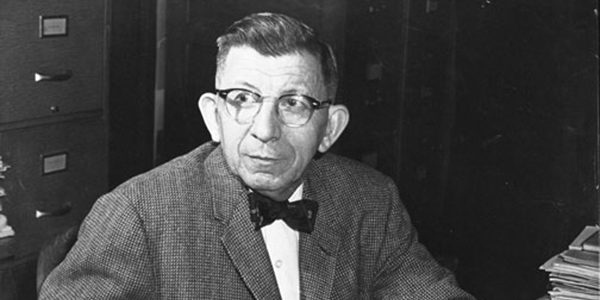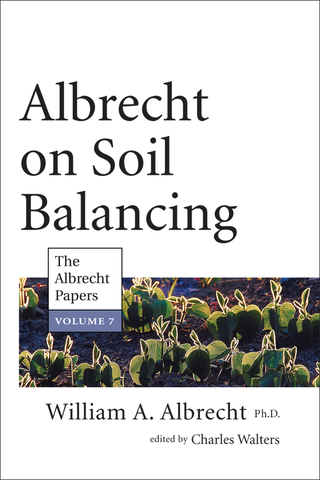Beginning in the late 1930s, Dr. William Albrecht contended that human health is inseparable from soil health. He was Chairman of the Department of Soils at the University of Missouri from 1938 through 1959 and President of the Soil Science Society of America. One study he published in 1947 examined the dental records of 70,000 U.S. sailors and concluded that the health of the sailors’ teeth was linked to the health of soils in their native regions.
Albrecht was a brilliant soil scientist but also a visionary and an humanitarian. He advocated for the restoration of the health of soils as a means to restore the health of people. Early in his career, Dr. Albrecht became increasingly alarmed about the declining health of Americans and by the 1950s, the transformation of farms to industrial operations.
In the 1940s, American companies began the development of chemical fertilizers and pesticides for use on farms. These same companies funded much of the research at Land Grant Universities that then promoted the widespread use of these chemicals as a means for boosting the production of food. Since the 1950s, the United States Department of Agriculture has focused most of its programs on furthering the industrialization of farming in this country.
Albrecht recoiled at this trend with its focus on N-P-K (Nitrogen-Phosphorus-Potassium) chemical fertilizers that neglected an array of other minerals essential to plant and animal health. Between 1938 and 1970, he was prolific writer of studies and papers, eventually setting the standard for “the ideal soil.” The key to successful farming, he concluded from three decades of research, was the proper balance of minerals in the soil, specifically, balancing the alkaline nutrients based on the soil’s capacity to hold them.
He called calcium the king of nutrients, since plants required it in greater amounts than any other mineral. He concluded that the ideal balance of calcium cations in the soil ranged from 60 to 75 percent, for magnesium it ranged from 10 to 20 percent, for potassium 2 to 5 percent and sodium 0.5 to 5 percent. Dr. Albrecht also stressed the importance of trace minerals such as manganese, copper, boron, zinc, iodine and chlorine.
Albrecht was a contemporary of J.I. Rodale. Rodale went on to become a household name and a leading figure in the organic farming movement. Albrecht understood the importance of organic matter in the soil but recognized the shortcomings of relying solely on organic material and avoiding chemical fertilizers and pesticides.
Albrecht might have been largely forgotten if it had not been for to his friend Charles Walters who founded the magazine Acres USA. Walters published some seven volumes of Albrecht’s writings in this magazine. Later, Walters published several books from the writings of Albrecht including Soil Fertility & Human and Animal Health and Albrecht on Soil Balancing.
Today, Albrecht’s work is being rediscovered. It has also been carried on by others such as Neal Kinsey who wrote Hands-On Agronomy and Michael Astera, author of The Ideal Soil, A Handbook for the New Agriculture.
CONCLUSION
Conduct a soil test at least once a year. This is a reminder to myself since this year I finally got around to testing my soil again after a four year hiatus. After ten years of building up my soil with compost, manure, cover crops and mulch, I was still missing the mark. I had an excess of calcium and a deficiency of potassium despite regular additions of greensand and other soil amendments. The soil was also below the mark on sulfur, boron, copper and zinc. I made various calculations using a spreadsheet and ending up adding ¾ lb. sul-po-mag per 64 square foot garden plot plus one lb. azomite to bolster the trace elements.
In the orchard, in its first year, there was a serious deficiency of calcium. The levels of magnesium and various trace elements also fell short. Despite prior additions of wood ash and lime the pH registered on the acid side, 5.4, one point below the recommended level. So, for each 100 square foot area that I had marked off around the fruit trees, I added 2.5 lbs. dolomite lime and 2.5 lbs gypsum. Based on my calculation, this should correct for the proper amounts of calcium, magnesium and sulfur, plus raise the pH by one point. I also added a pound of azomite plus another ten gallons of compost per 100 square feet area.
I recently bought an Oakfield 19″ Tube Soil Sampler to facilitate gathering the soil samples for next spring. I will be using Logan Labs again in Lakeview, Ohio (https://www.loganlabs.com/) as they provide results that supply most of the information needed to compare your soil to what is ideal. Soil tests are not expensive and are one of the best investments you can make in your garden.
The goal is to produce nutrient-dense food: your health depends on it. Yes, eat your fruit and vegetables. But not all fruit and vegetables are created equal. A properly balanced soil — an ideal soil — should result in healthier food.
Also, a recent article in the New York Times reported, “Now a new French study that followed 70,000 adults, most of them women, for five years has reported that the most frequent consumers of organic food had 25 percent fewer cancers overall than those who never ate organic. Those who ate the most organic fruits, vegetables, dairy products, meat and other foods had a particularly steep drop in the incidence of lymphomas, and a significant reduction in postmenopausal breast cancers.”
The Law of the Minimum A related concept that was developed earlier is called the law of the minimum. Around 1828, Carl Sprengel, a German botanist, formulated this principle. Shortly, thereafter, another German, biochemist Justus von Liebig expanded on and widely disseminated this idea. Thus, it also became known as Liebig’ Law of the Minimum. Simply stated, plant growth and health is not a function of the total amount of nutrients available in the soil but controlled by the scarcest nutrient available. Thus, it is like the weakest link in a chain: the growth and development of your plants will be limited by the nutrient in shortest supply.






